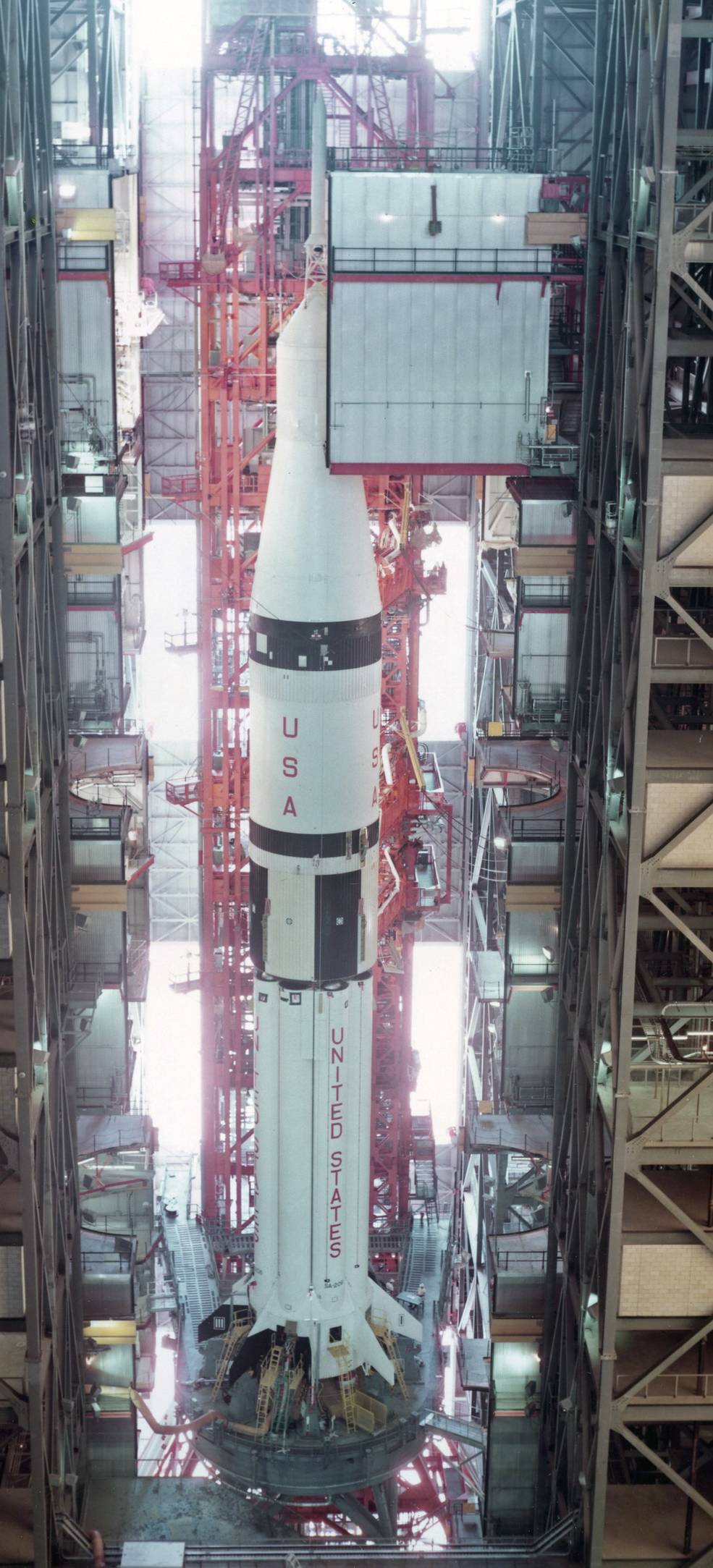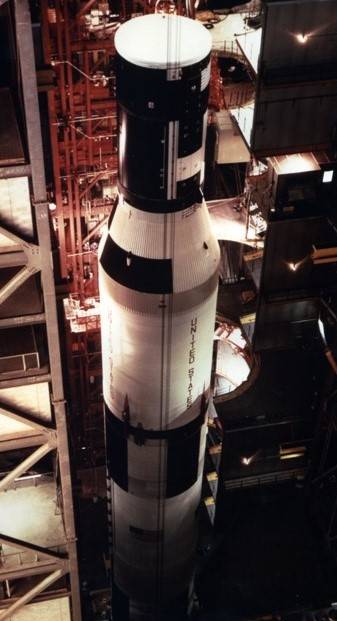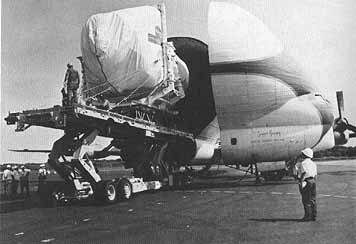In October 1972, while preparing for the final Apollo Moon landing mission, workers across NASA also continued preparations for Skylab, America’s first space station, then scheduled for launch on April 30, 1973. In the Manned Spacecraft Operations Building (MSOB) at NASA’s Kennedy Space Center (KSC) in Florida, workers tested and prepared the components of the space station and the Apollo spacecraft for the first crew’s mission. Workers in KSC’s Vehicle Assembly Building (VAB) began to stack two launch vehicles, the Saturn V to launch the Skylab 1 space station and the Saturn IB to launch Skylab 2, the first crew to live and work aboard the station. The Skylab 2 crew of Charles “Pete” Conrad, Joseph P. Kerwin, and Paul J. Weitz completed a two-week simulation of their mission.





Left: The Saturn IB for the Skylab 2 crew mission stands on the pedestal in High Bay 1 of the Vehicle Assembly Building (VAB) at NASA’s Kennedy Space Center. Middle left: The Skylab Orbital Workshop (OWS) arrives in the VAB. Middle: Workers in the VAB lift the OWS in preparation for stacking it onto the Saturn V rocket. Middle right: Workers have mated the Skylab OWS with its Saturn V rocket in the VAB’s High Bay 2. Right: In the foreground, workers install one of the solar array wings on the OWS, with the Saturn IB rocket is visible in the background.
Workers in the VAB remained very busy in October 1972. Until the Apollo 17 stack rolled out to Launch Pad 39A in late August, they processed three launch vehicles in parallel in three adjacent high bays. With High Bay 3 vacated by Apollo 17, assembly of the two-stage Saturn V for the Skylab 1 space station proceeded in High Bay 2, and of the Saturn IB rocket for Skylab 2, the first crew to occupy the station, in High Bay 1. A 128-foot tall pedestal more commonly known as the milkstool allowed the smaller Saturn IB rocket to use the same facilities on the mobile launcher as the larger Saturn V. Workers completed assembly of the powered stages of both rockets in September. The Skylab Orbital Workshop (OWS) arrived in the VAB on Sept. 23, and workers stacked it atop the Saturn V rocket six days later. The planned four-day installation and test of the OWS micrometeoroid shield in early October ran into problems and took several weeks to complete. Workers installed the two large OWS solar array wings in mid-November. While the actual Command and Service Module (CSM) for Skylab 2 continued testing in the MSOB, workers installed a Facility Verification Vehicle, a boilerplate Apollo spacecraft (BP-30), atop the Saturn IB to carry out tests of the rocket, the milkstool, and eventually the launch pad.



Left: Skylab’s Apollo Telescope Mount arrives in the Manned Spacecraft Operations Building (MSOB) at NASA’s Kennedy Space Center in Florida. Middle: Workers offload the Skylab Airlock Module (AM) and Multiple Docking Adapter (MDA) from a Super Guppy cargo aircraft at Cape Canaveral Air Force Station, now Cape Canaveral Space Force Station, in Florida. Right: The combined AM/MDA in a work stand in the MSOB.
Other components of Skylab arrived at KSC. The Apollo Telescope Mount (ATM) arrived at the Skid Strip at the nearby Cape Canaveral Air Force Station, now Cape Canaveral Space Force Station, aboard a Super Guppy cargo aircraft on Sept. 22. Workers immediately installed it in a clean room in the MSOB to begin testing its systems. The Airlock Module and Multiple Docking Adapter arrived on Oct. 6, also by Super Guppy, and joined the ATM at the MSOB for testing. The CSM-116 for Skylab 2 had been in the MSOB since July undergoing systems testing in an altitude chamber.



Left: Training modules of the Skylab space station in the Mission Simulation and Training Facility at the Manned Spacecraft Center (MSC), now NASA’s Johnson Space Center in Houston. Right: Skylab-2 astronauts Joseph P. Kerwin, left, Charles “Pete” Conrad, and Paul J. Weitz conduct medical experiments during a simulation. Right: Weitz, left, and Conrad train on the use of the wardroom table.
Between Sept. 6 and 20, Skylab 2 astronauts Conrad, Kerwin, and Weitz, and their backups Russell L. Schweickart, Dr. F. Story Musgrave, and Bruce McCandless, participated in 11 days of simulations of the first mission aboard the Skylab space station. The crews worked alternately in the Skylab and Command Module simulators and the ground-based trainers of the Skylab space station, located in the Mission Training and Simulation Facility in Building 5 of the Manned Spacecraft Center (MSC), now NASA’s Johnson Space Center in Houston. They simulated 11 different days of the planned 28-day mission.



Left: Astronaut Dr. William E. Thornton, left, monitors Karol J. “Bo” Bobko as he exercises during the Skylab Medical Experiment Altitude Test (SMEAT). Middle: A SMEAT astronaut demonstrates a collapsible drink container at the wardroom table. Right: Astronauts Robert L. Crippen, left, Bobko, and Thornton exit the chamber at the end of the 56-day SMEAT.
On Sept. 19, astronauts Robert L. Crippen, Dr. William E. Thornton, and Karol J. “Bo” Bobko completed the 56-day Skylab Medical Experiment Altitude Test (SMEAT). NASA established SMEAT to obtain baseline data on the medical experiments planned for Skylab, to evaluate the hardware and procedures for those experiments, and to gain experience with long-duration operations. Crippen, Thornton, and Bobko conducted the test in the 20-foot altitude chamber in Building 7 of MSC’s Crew Systems Division. NASA documented the results of the test and many critical lessons learned from the test in the SMEAT final report, released on Oct. 18. Changes recommended based on the SMEAT experience ensured the success of the three Skylab missions.
With special thanks to Ed Hengeveld for providing imagery and guidance.
To be continued …
John Uri
NASA Johnson Space Center


























